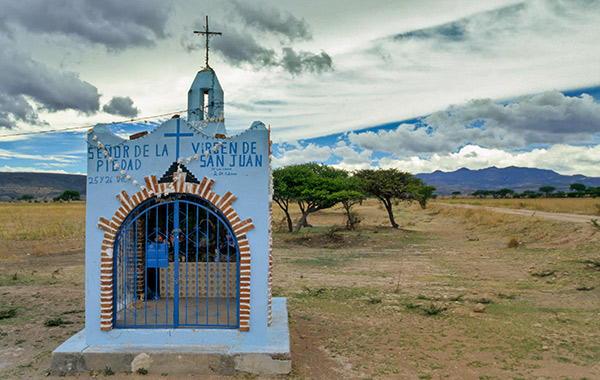Subtotal: $
Checkout
The Imprisoned Christ
We must liberate Christ from the prisons we make for him.
By Gonzalo Báez Camargo
March 3, 2024
Available languages: Español
In my childhood home of Oaxaca, Mexico, when Holy Week arrived with its traditions that were often more boisterous than sacred, I used to walk along gazing at the carved wooden shrines depicting the Stations of the Cross and other events of Jesus’ life, which had been erected to aid the prayers of the faithful.
With the exception of the shrine of the Samaritan woman, under whose gaze we little ones found enough fresh water to fill our modest jugs or ambitious bottles – anything conducive to furtive, sweet sips – there was none that impressed my nascent powers of meditation more than the niche which held a suffering and bloody Christ. He was dressed in a not-always-well-adjusted purple tunic and seemed to arouse the morbid compassion of the spectators on his side of the iron grille, those arrogant effigies representing Roman soldiers and Jewish leaders.
It was the shrine of the imprisoned and suffering Christ.
That grille, which I now glimpse in the depths of my memories, has become a somber symbol for me in light of what the years have taught me and of what my intuition, now slightly more acute, can perceive. Grille! Prison!

Photograph by Witold Skrypczak / Alamy Stock Photo.
Christ’s Many Prisons
For many, Christ is imprisoned in the material forms that have been made of him. Diverse forms of anthropomorphic images; crude forms, like all matter, in spite of the artistic elevation they sometimes reach. Ricardo Rojas, the great South American mystic, strives to unearth the authentic portrait of the Master from among the stupendous variety of Christian iconography. But his fine intuition declares it to be impossible. Therefore, certain that the human likeness of Jesus cannot be restored in any of his images, he frees Christ from form and exalts him in spirit. But for the credulous masses, Jesus remains trapped in the immobile and solitary prison of the form, as long as the material of which the image is made endures.
Others hold Jesus captive within the rigorous prison of time. For them, Jesus is only a historical figure. A man named Jesus, they say, a native of Palestine, lived, preached, and died two thousand years ago, and remains locked inside a prison known as the years 4 BC to AD 30. He can only be present today as a mere memory or pious tradition.
Christ has to free himself from all his prisons save one: that of the heart which loves him and serves him in word and deed.
And the theologians, those dissectors of life and soul, have locked Jesus up in the prison of concepts, abstract ideas, and the “ergo” and “nego” of syllogistic farce. They have attacked Christ with the sticks and swords of their analyzing and philosophizing wit. They have tied him up and dissected him, and then given him to us – the Christ who said, “I am … the Life” – as a barren, frigid, and chartaceous definition. And when they have done this, they have arrogantly declared: “Are you looking for Christ? We have him within our grasp. Here he is for you.” And they throw to us souls who are hungry for him, the bagasse and husks of their syllogisms and dialectical subtleties.
Then the ecclesiastics, those sectarian apologists, arrive in choleric droves and assure us that they possess Christ, that they have him imprisoned within the rules and creeds of their respective institutions. Outside of their church, each one implies, you won’t find Christ. It is a matter, then, of exclusive rights, where Jesus is monopolized. They forget, while they deny each other the possibility of possessing Christ, that religious societies of whatever denomination and churches by whatever name only have Christ when they have his spirit, and only to the extent that they do. One can participate in Christ, but not monopolize him. One can be with him, but not exclude others from his presence.
The Deliverance of Christ, Prisoner of Love
Christ is more than all of this. More than a form, more than a simple historical figure, more than a definition, more than the ornament of an exclusive institution. Christ – and I am neither defining nor pretending to define – is spirit. He is a universal and eternal spirit, a force that operates vigorously in the depths of every enterprise of love, a fire that – like that of the bush at Sinai – burns the heart without consuming it and, in the process, purifies and renews it unceasingly.
It is one thing to fix Christ in a form and prostrate oneself before it, or to imprison him in time and dedicate oneself only to recalling him as a historical fact, or to enclose him in a cold definition and then learn it by heart, tacking on a faint “I believe,” or to feel Christian because one belongs to a certain religious group. It is quite another thing to have Jesus.
Only those who feel him as an immediate and actual reality can say that they have him. Whoever does not feel this way has no choice but to rush into religious materialism, historical dilettantism, scholastic pedantry, or spiritual parasitism. Or, as has happened lately, into the denial that is inspired, in the words of Miguel de Unamuno, by “the rage of not being able to believe.”
Christ is still a prisoner. It is necessary to free him and give him back to humanity. From behind the cold iron grille, as in the shrines of my childhood memories, Jesus looks at the hungry crowds thirsty for truth, who bloody their hands, their chests, their faces, as they tragically fling themselves against the prison in their efforts to reach him.
But is Christ really a prisoner; is he really bound and imprisoned? In any case, the forms, the philosophies and, frequently, the institutions themselves, are placed – like heavy, shameful stones – on the road that leads to Jesus. And because of this, many souls stumble and fall and remain without him, because they cannot reach him.
The gentle yet energetic Teresa of Ávila also perceived Christ as a prisoner. But in what a way! “This divine union of love with which I live, makes God my captive and my heart free.”
They are not, then, walls of formulas, nor rites, nor material forms, nor definitions, nor regulations, nor ecclesiastical canons, within which the spirit of Christ is truly imprisoned. No, rather, they are the fiery bars of love. For after all, as illustrated by that other mystical lover, Saint John, and with him all Christians of all ages who have felt Jesus’ animating and dynamic spirit pervading their whole life, Christ has to free himself from all his prisons save one: that of the heart which loves him, follows him, and serves him in word and deed.
Thus, the only way to liberate Christ is to imprison him within the jails of our hearts, and make him, in those inner depths, the source of new and abundant life.
Source: Pedro Gringoire, Las Manos de Cristo (México, D.F.: Casa Unida de Publicaciones; Buenos Aires: Editorial La Aurora, 1950), 90–97. Translation by Coretta Thomson.
Already a subscriber? Sign in
Try 3 months of unlimited access. Start your FREE TRIAL today. Cancel anytime.






